Colosseum Games Martyrs | Location | Opening Hours Tickets | Authorisations | Roman Forum
Games Martyrs Story Architecture | Games Gladiators | Martyrs
The Colosseum in Rome, Combats of Gladiators, Sacred and Political Games
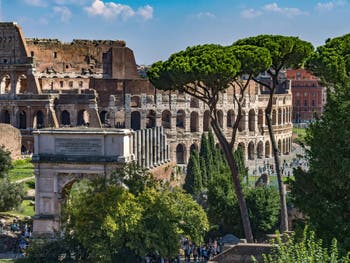
Colosseum Arena in Rome In Roman antiquity, most sports and games had a sacred connotation.
The games thus included a ceremony from which the emperor himself gave the signal of departure. A procession where the statues of the deceased emperors were walked through the arena.
The games also had a civic and political role and symbolized the link between the population and its leader through joint participation in a major public event.
Moreover, while the people were entertained with “Panem et Circenses”, bread and games, one diverted attention from possible problems: a “recipe” that modern emperors around the world have not forgotten.
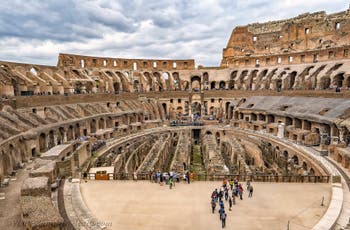
Colosseum Arena in Rome This formula “Panem and Circenses” is taken from the “Satires” (X, 81) of Juvenal (65-128 AD).
In this book the poet, who opposed vice and corruption in Roman society of his time, said that the people wanted only entertainment and food, and that the emperors, wishing to please the Roman plebeians, organized public performances and banquets to satisfy it.
Indeed, the Colosseum was an ideal tool to strengthen the social cohesion of the Roman people, perfectly illustrating the demagogic policy of the Flavian emperors.
Colosseum in Rome: Free Games and Numbered Seats
The circus games were a gift from the emperor to the Romans. All expenses were paid by the emperor himself.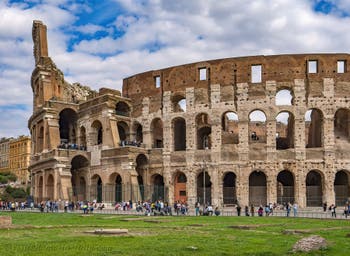
Colosseum Arena in Rome Because of their often astronomical cost, the games were organized only for exceptional occasions: major military victories or civil or religious celebrations.
Depending on the type of occasion, the games lasted longer or shorter, but, whatever the event, they always lasted for at least several days in a row, with thousands of animals and gladiators.
Free access was therefore necessary, which did not prevent the regulation of access to the stadium in an organized manner.
Each Roman allowed to attend the games was assigned a sitting or standing position, giving him a numbered plaque.
Thanks to this number, everyone knew which door to enter to access his place, because the groups of numbers corresponding to the different sectors were engraved on the arcades of the amphitheatre. Numbers that can still be seen today.
123 Days of Games in the Colosseum to Celebrate Trajan
We didn't go to the stadium every Sunday like today.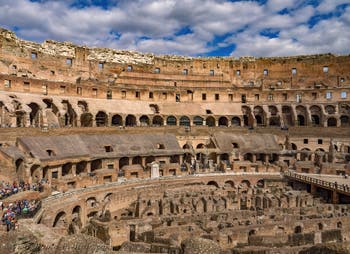
Colosseum Arena in Rome The games were mainly reserved for special occasions, religious holidays or victories over the enemies of Rome.
On the other hand, they often lasted several days with some notorious exceptions for the Colosseum. At the inauguration of the Colosseum, the games lasted 100 consecutive days during which more than 5,000 wild beasts were killed, and thousands of gladiator fights were organized.
But the peak was achieved during the celebration of Emperor Trajan's victory over the Dacians in AD 107. The games in the Colosseum lasted 123 consecutive days, 11,000 great beasts were killed and 10,000 gladiators participated in the fighting!
Fighting and hunting of wild animals usually took place in the morning, the spectators then left the stadium for a lunch break and returned in the afternoon to watch the gladiator fights.
The Combats of Gladiators at the Colosseum, the Art of Fighting and Money
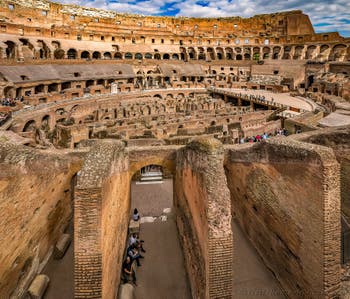
Colosseum Arena in Rome First of all, gladiators were free to fight, and it was exceptional that they could be forced to do so against their own will.
However, it is true that some of the gladiators consisted of prisoners of war who were left the choice, if they had the physical requirements, between becoming slaves or fighting in the arena.
In this case, this commitment was only for a limited period of time, and it was also contractually defined.
At the end of the fighting provided for in the contract, the one who had the chance to survive not only regained freedom, but also received the gains accumulated from the battles won, which were often considerable.
This possibility of rapid and significant enrichment, as well as the taste of risk and glory, also attracted many Romans to the profession of gladiator.
Gladiators, like our current actors and singers, enjoyed great prestige in Roman society, and many young women were in admiration for these men who could risk their lives.
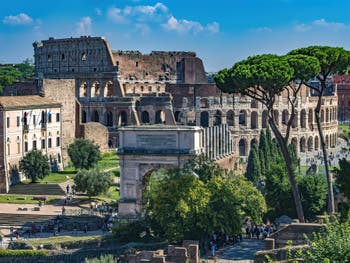
Colosseum Arena in Rome This attraction was such that even members of the Roman horsemen class, a social class immediately lower than that of senators, did not hesitate to enter the arena to fight.
This enthusiasm was such that Roman riders had to be banned from participating in the games.
The art of the gladiator also showed his courage in facing death as his ability to bear pain.
In a Roman society whose greatness and wealth were largely based on the battles won against the enemy, these virtues were obviously particularly important and appreciated by the people, as well as by the authorities.
Several fights took place in the arena simultaneously, involving different types of weapons (swords, daggers, tridents, etc.), so that the show never stops to maintain the attention of the spectators.
Ave Caesar, those who are going to die greet you.
It was to the emperor himself that the gladiators presented their weapons before the start of the fighting, uttering this famous phrase: “Ave, Cesare, i morituri te salutant”.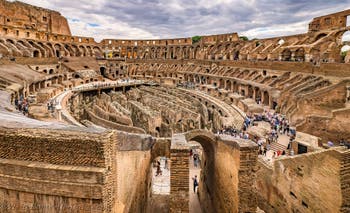
Colosseum Arena in Rome For any gladiator, the main rule was to behave with courage and dignity.
If the gladiator respected this principle, he had every chance to stay alive, even losing his fight.
The value of the fighter and his contempt for death were indeed essential criteria for attracting the favours of the spectators.
Spectators who, via the present emperor, had the power to stop the fight to save the life of the loser by raising their thumbs or by waving their handkerchiefs.
In general, the gladiator who lost his fight had life saved.
Historians of the time determined that only 14% of professional gladiators died during the games. Serious injuries were usually the cause of death, so voluntary killing was exceptional.
It should also be noted that a professional gladiator participated on average only two fights a year.
Women and Children's Fighting Gladiators at the Colosseum
Gladiators Women, Children, Dwarves and the Abolition of Fighting
It is also known from the texts of Martial (40-104 AD) that there were in the Colosseum, other shows highly appreciated by spectators, fights of women gladiators.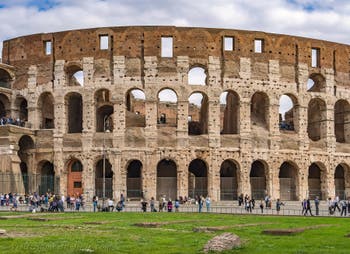
Colosseum Arena in Rome And women weren't the only ones involved in these fights. The same poet Martial also reports fights between children and dwarves.
It should also be noted that in many cases, for women and children as well as for men, gladiator fights were simulated and therefore ended without a single drop of blood being shed.
The battles of gladiators, and with them the long career of the Colosseum, came to an end at the beginning of the fifth century with their abolition by the Christian emperors.
A decision probably related to the tragic end of Telemaco, a monk who had jumped into the arena to stop the fighting and who had been stoned by the angry crowd.
Gladiator Barracks and Battle Organization
There were four gladiator schools around the Colosseum.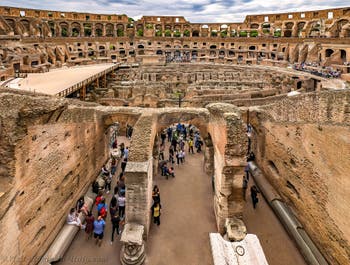
Colosseum Arena in Rome They had an oval shaped arena with a few bleachers for spectators allowed to attend the workouts.
In the Colosseum itself, under the arena, there was an armoury, an important element for the safety of spectators, but also of the emperor and the highest authorities present during the games.
The weapons were thus kept in this secure place and only released those that were necessary for the ongoing fighting.
There was also an infirmary and a hospital dedicated to gladiators, as well as a “spoliarum” a mortuary chamber for the less fortunate.
Access to the morgue, hospital or gladiators' barracks was through tunnels that passed under the Colosseum.
The most seriously injured gladiators who lost consciousness were hit with a slight mallet on the forehead to see if they were reacting.
This operation was carried out by a man wearing the mask of the god Mercury, the guide to the afterlife.
And if the wounded did not react to the mallet, Mercury's representative would give him the blow of grace.
The Colosseum, a very sophisticated Arena, Naval Fights
An Arena worthy of the current Opera Scenes
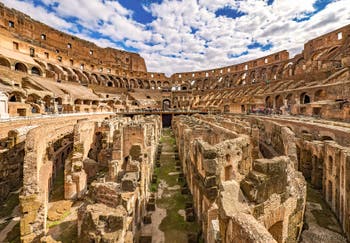
Colosseum Arena in Rome Imagine that naval battles, gladiator fights, wild animal hunts and other spectacular attractions took place here.
And this with thousands of participants, 10,000 gladiators and 11,000 felines for the games of Trajan in 107: impossible to achieve without a perfect orchestration of the stage.
The Colosseum Arena, which was 86 metres long and 54 metres wide, consisted of a wooden floor covered with a thick layer of sand.
It was also this sand, the “rena” that gave its name to the “arena”.
Under the arena, what can be perfectly seen today by visiting the Colosseum since this floor no longer exists (except a very small part reconstituted), there was a maze of corridors and rooms all having a very precise function.
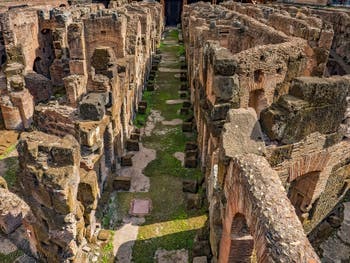
Colosseum Arena in Rome In this underground labyrinth were rooms for show operators, cages for lions, warehouses for equipment and weapons, infirmaries, slide systems, pit opening systems, counterbalance lifts to lift animals, but also all stage accessories.
A complex system that included about 70 elevators, inclined planes and hatches, which allowed the arena to appear simultaneously and unexpectedly: gladiators, lions, bushes, trees, rocks, artificial hills and other accessories capable of amazing and enthusiasm the public.
To perform all these manoeuvres, 450 operators were needed, all with a specific task to accomplish.
It was necessary to guide the wild animals from the cages to the elevators, accompany the gladiators to the precise location of their combat station, give them their weapons, operate winches, take care of illumination with torches and oil lamps, bring up and disappear the elements of the scenery of each scene, etc., and all without breaking in the sequence of the pace of the show.
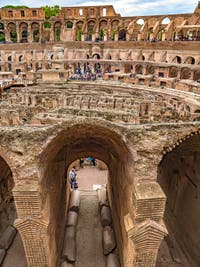
Colosseum Arena in Rome All this underground structure was made of wood, completely removable, until Emperor Domitian decided to do naval battles and water games in another place located in the district of Trastevere. We could then build sturdily the entire service area under the arena, as can now be seen by visiting the Colosseum.
Naumachiae at the Colosseum: Aquatic Games and Naval Fights
For aquatic games, the floor of the arena as well as the entire underground part were completely dismantled to fill the centre of the Colosseum with water.A very easy operation, since in the very place where the Colosseum was built was the artificial lake of the Domus Area of Nero.
In addition, the water inlet pipes, which remained in perfect working order, made it easy to fill the trough of the arena.
But one was not content to create a simple table of water, it was usually installed in the middle of one or more artificial islands with gardens and groves.
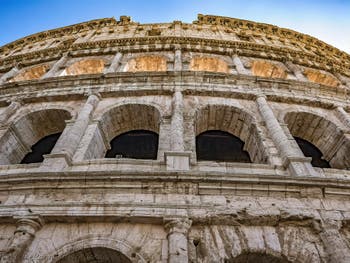
Colosseum Arena in Rome Thus naval battles, Naumachies, could be even more realistic and strategically more interesting.
Once the water games were completed, the pond was emptied and the entire wooden structure, the elevators and other mechanisms, and the arena were lifted.
But these naval battles took place only twice in the Colosseum before being transferred to the stadium built by Augustus in the district of Trastevere.
Lions and Wild Beast Hunting, Elephants at the Colosseum
Wild animals were not the only animal attraction of the Colosseum.Animals trained for the occasion were also part of the circus games.
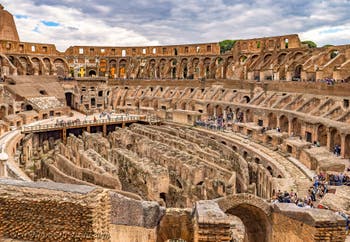
Colosseum Arena in Rome It is known that a trained elephant knew how to write letters on the sand of the arena using his trunk.
The wild animals could fight with each other or be executed in hunts by gladiators.
For this purpose, artificial hills, groves, rocks and trees were installed in the arena of the Colosseum.
These hunts and the presence of lions in the heart of the Colosseum crowd required the implementation of protective measures in the event that lions managed to save themselves and threaten the lives of spectators.
During the performances involving wild beasts, a barricade made up of elephant tusks was installed on the entire perimeter of the arena, with their tips directed towards the centre.
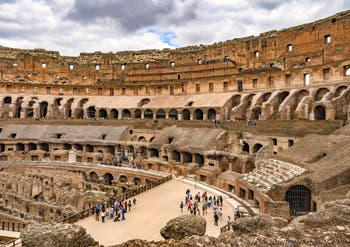
Colosseum Arena in Rome In addition to this barricade, archers were added positioned all around the arena, ready to shoot animals that become threatening to the crowd.
It is not known where the menagerie to keep the wild beasts participating in the Colosseum shows took place.
It had to be particularly large when we know that for some games were killed up to 11,000 wild animals.
What is certain is that this menagerie had to be far from the centre of Rome.
The animals were transported to the Colosseum, where they were confined for a day or two in the cages of the underground under the arena.
Games Martyrs Story Architecture | Games Gladiators | Martyrs
Colosseum Games Martyrs | Location | Opening Hours Tickets | Authorisations | Roman Forum
Back to Top of Page

